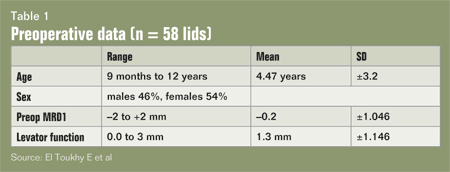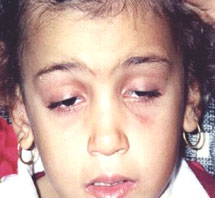Modified frontalis muscle flap advancement can correct pediatric blepharoptosis
When ptosis is associated with poor levator muscle function, frontalis muscle sling is usually the procedure of choice.
Ptosis is the most common lid malposition encountered in clinical practice in children. Several sling materials have been used, including fascia lata (autogenous or preserved) and synthetic materials such as silicone rods, sutures and meshes. Frontalis muscle flap advancement for correction of blepharoptosis can be used instead of graft or suture materials.
The major advantage of frontalis muscle flap advancement is that the muscle flap directly connects the frontalis muscle to the eyelid; therefore, the frontalis muscle directly elevates the eyelid without the need for a graft or synthetic material as in traditional frontalis muscle suspension.
The frontalis muscle is well developed in infancy and may be used in young children before fascia lata maturation, and there is no need for harvesting fascia from a distant donor site.
In this article we report on a large series of cases of congenital ptosis repaired by frontalis muscle advancement flap, together with a modification of previously published surgical techniques.
Subjects and method
This study included 58 lids of 56 patients with ptosis and eyelid excursion measured as poor or less than 4 mm.
All patients were subjected to full ophthalmologic exam.
Slit-lamp examination, fundus examination and refraction were done. Best corrected visual acuity was measured, and presence or absence of amblyopia was noted. Extraocular muscle functions were evaluated for any associated abnormalities. All patients were tested for jaw winking syndrome and Bell’s phenomenon.
The amount of ptosis was measured using the margin reflex distance 1(MRD1), which is the distance from the light reflex to the center of the upper lid margin in primary position. Measurement of the vertical interpalpebral fissure height was also recorded. Measurement of levator muscle function was performed by measuring the excursion of the upper eyelid from downgaze to upgaze with the frontalis muscle fixed. Cases with 5 mm or more of function were excluded. Orbicularis muscle function was assessed by noting eyelid closure.
The etiology of ptosis was congenital in all cases. Five cases had abnormal head posture (chin up position). The preoperative data in regard to age, sex, degree of ptosis and levator function are shown in Table 1.

|
Images: El Toukhy E et al |
Surgical technique
The frontalis was exposed through a horizontal incision starting lateral to the supraorbital notch, avoiding the supraorbital nerve and vessels. A subcutaneous plane was dissected downward to expose the orbicularis muscle, and dissection was continued upward to expose the anterior surface of the frontalis as well. The frontalis was then incised along its attachment to the brow and a flap of 1 cm to 2 cm in length is fashioned. Two vertical incisions were made to fashion a rectangular tongue of the muscle 7 mm to 12 mm wide to be advanced to the tarsus and sutured to the upper third of the tarsus with two 6-0 polypropylene sutures through a second lid crease incision.
In bilateral cases the eyelid margin is set at or 1 mm above the limbus on both sides. In unilateral cases the lid is set 2 mm to 3 mm above the level of the non-ptotic lid.
After some undercorrection in the first three cases, we started suturing the side of the flap to the original frontalis muscle, helping to maintain the level of the lid higher as needed. Finally, the two incisions were closed with interrupted sutures.
Patients were seen for follow-up at 1 week, 6 weeks, 6 months and 1 year.
The surgery was primary in 55 cases and secondary in one case of previous levator resection and two cases of previous sling procedure.
Results
The improvement of lid height was significant in all cases. Table 2 shows the postoperative results.
Residual ptosis of +2 mm or less occurred in three cases (11%). One of them was redone with the modified technique and corrected, and in the other cases the parents refused a reoperation.
One of the first cases developed entropion due to lower insertion of the flap in the middle third of the tarsus. It was repaired by reinsertion of the flap in the upper part of the tarsus.
Suture infection occurred in three patients. It was managed by removal of the suture, drainage of the pus and administration of systemic antibiotic. The flap was not affected, nor was its attachment to the tarsus.
No cases of overcorrection were noticed. The postoperative lid height attained at the 6-week visit was stable and maintained thereafter. Lagophthalmos was temporary in the first few days until edema resolved and the patient could close his eyes by orbicularis contraction. One case had corneal exposure, and lubricants were prescribed until it resolved in about 4 weeks.
Asymmetry between the lids of more than 1 mm occurred in three patients with unilateral surgery and in one patient with bilateral surgery. The incidence of lid lag in downgaze was almost 100% in all patients.

|
|
Discussion
Frontalis muscle surgery has long been accepted as the best technique for managing blepharoptosis with poor levator muscle function.
Frontalis muscle flap advancement is a technique of direct transfer of the force of the frontalis muscle to the eyelid without the insertion of fascia, suture or a graft between the muscle and the tarsus. The flap elevates the ptotic eyelid through the normal contraction of the muscle.
In our study a direct frontalis muscle flap was used to treat congenital eyelid ptosis. The first three lids had an undercorrection with a residual ptosis defined as MRD1 of +2 mm or less in the primary position. This residual ptosis was suspected due to stretch of the flap.
Accordingly, in all cases afterwards, the side of the flap was sutured to the original muscle after suturing the distal end of the flap to the tarsus. All lids done with this modified technique had a satisfactory result. One of the three undercorrected cases was redone with the modified technique and had an increase in lid height from MRD1 +2 mm to +4 mm in the primary position.
In our cases, lid lag on downgaze occurred in almost all cases. It is an inherent side effect of all frontalis muscle surgery. If well explained to the parents, it is usually accepted as the price for correction of the ptotic lid in primary position and in upgaze.
Lagophthalmos was present as a temporary phenomenon in the first few days postoperatively only. It disappeared with the full recovery of orbicularis function. Even when it was prolonged in one case, the use of lubricants for 1 month was sufficient to prevent any corneal problems.
Goldey and colleagues reported that nine of 10 ptotic eyelids were repaired by the frontalis muscle flap technique. They reported a cosmetically acceptable result with a correction differing by 1 mm from the level set at surgery. Our results suggest that suturing the side of the flap to the muscle would result in maintaining the level set at surgery without the undercorrection that occurred postoperatively.
We agree with other reports that a flap width of 7 mm to 12 mm is sufficient to elevate the lid, particularly with a flap made in a rectangular fashion. The length of the flap will depend on the amount of the ptosis and the required lid height. The more severe the ptosis, the shorter the flap. In this aspect, the flap acts like a harness; the shorter it is, the closer the insertion (tarsus) is to the origin (brow), ie, the higher and tighter the lid. Accordingly, based on this experience, we believe that adjustment of the lid height can be done using recession or resection of the flap in cases of under- or overcorrection postoperatively. We are currently studying this technique.
To avoid using synthetic materials in brow suspension, autogenous fascia lata can be harvested. However, this can only be done when a child is at least 2.5 to 3 years of age. In contrast, frontalis muscle flap surgery can be done in infants before fascia lata maturation.
Suture infection occurred in three patients in our study and was managed by removal of the suture, drainage of the pus and administration of systemic antibiotics. The lid level was not affected. Suture infection and/or granuloma formation is a well-recognized complication of frontalis sling procedures. However, its treatment may necessitate removal of the sling and recurrence of ptosis.
In conclusion, frontalis muscle flap advancement is a valuable technique in the management of severe ptosis with poor levator function in children. Our modified technique helps to prevent postoperative undercorrection by preventing overstretch of the flap.
For Your Information:References:
- Essam El Toukhy, MD, FRCOphth, can be reached at 14-A El Sobki St., Dokki, Cairo, Egypt, 12311; e-mail: eeltoukhy@yahoo.com.
- Downes RN, Collin JRO. The Mersilene mesh sling – a new concept in ptosis surgery. Br J Ophthalmol. 1989;73:498.
- Goldey SH, Baylis HI, et al. Frontalis muscle flap advancement for correction of blepharoptosis. J Ophthal Plast Reconstruct Surg. 2000;16:83-93.
- Han K, Kang J. Tripartite frontalis muscle flap transposition for blepharoptosis. Ann Plast Surg. 1993;30:224-232.
- Hintschich CR, Zurcher M, Collin JRO. Mersilene mesh brow suspension, efficiency and complication. Br J Ophthalmol. 1995;79(4):358.
- Song R, Song Y. Treatment of blepharoptosis: Direct transplantation of the frontalis muscle to the upper eyelid. Clin Plast Surg. 1982;9:45-48.
- Wagner RS, Mauriello JA , et al. Treatment of congential ptosis with frontalis suspension: A comparison of suspensory materials. Ophthalmol. 1984; 91(3):245-248.



